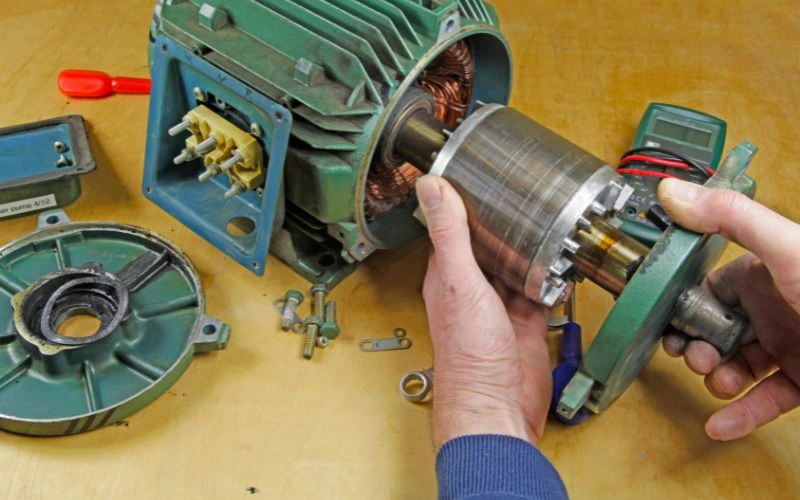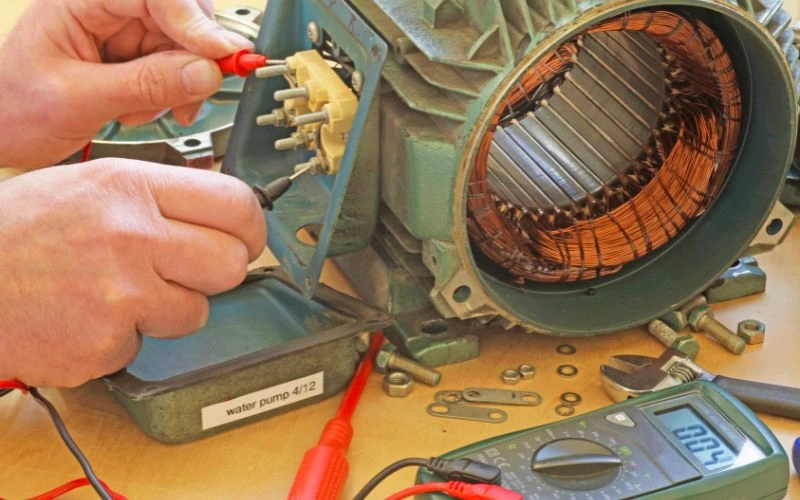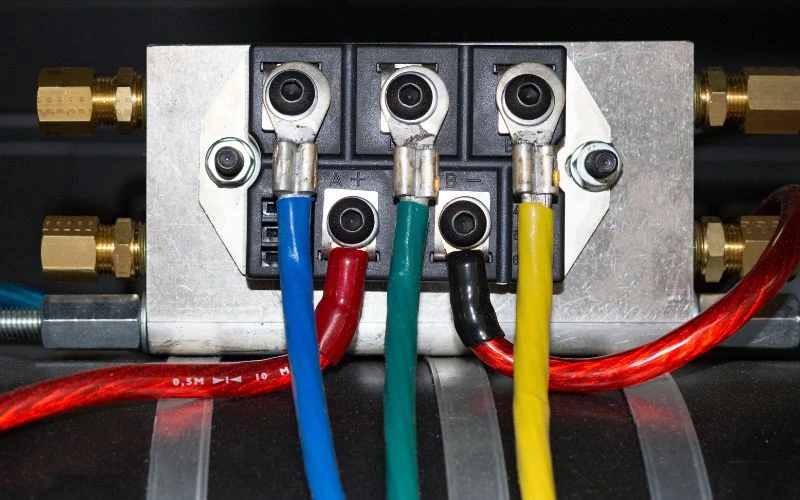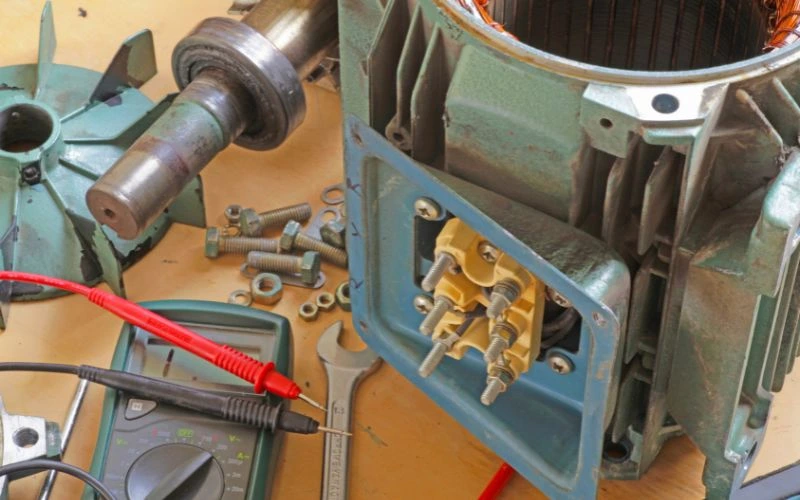
Speed control is a crucial aspect for optimizing the performance of three-phase induction motors. These motors are used in numerous industrial applications and require precise control of their speed to ensure efficient operation. From driving pumps and compressors to driving conveyors and fans, the ability to regulate the speed of these motors opens up countless opportunities to increase productivity and save energy.
In this introductory part we delve into the fascinating area of speed control for three-phase induction motors. By examining the underlying principles and techniques, we aim to provide a solid foundation for further exploration of this compelling topic.
The first step to understanding speed control is to understand the basic operation of a three-phase induction motor. These motors use electromagnetic induction to create a rotating magnetic field that drives the motor's rotor. By manipulating the frequency and voltage supplied to the motor, we can precisely control its speed.
There are several methods for achieving this control, each with its own advantages and considerations. The most commonly used techniques are voltage control, frequency control, and variable frequency drives (VFDs). Each method offers a unique approach to changing engine speed, allowing flexibility and adaptability in different applications.
In this exploration, we will take an in-depth look at the intricacies of each speed control method and examine their advantages, limitations, and practical applications. We will also examine the impact of cruise control on engine efficiency, power factor, and overall system performance.
Join us on this exciting journey through speed control for three-phase induction motors. Together, we will discover the secrets to harnessing the power of precision, optimizing operations, and achieving unparalleled efficiency in diverse industrial environments. Stay tuned for an insightful and informative look at this interesting topic.
Speed control of a three-phase induction motor
Speed control of three-phase induction motors is crucial in several industrial applications. By controlling the speed of these motors, we can optimize their performance and increase efficiency. In this article, we will explore various methods and techniques for speed control of three-phase induction motors.
A commonly used method is voltage regulation. By adjusting the voltage supplied to the motor we can control its speed. This method is simple and inexpensive and therefore suitable for many applications. However, it has limitations in terms of speed range and torque control.
Another method is frequency control. By varying the frequency of the power supply we can control the speed of the motor. This method provides a wider speed range and better torque control than voltage control. However, it requires complex control circuits and is more expensive.
Pulse width modulation (PWM) is another popular technique for speed control of three-phase induction motors. The width of the pulses in the power supply is varied to control the speed of the motor. PWM control provides precise speed control and high efficiency. It is often used in applications that require precise speed control, such as: B. in robotics and automation.
In recent years, technological advances have led to the development of sensorless control methods for three-phase induction motors. These methods eliminate the need for external sensors, thus reducing costs and complexity. Sensorless control techniques such as vector and direct torque control offer better performance and efficiency.
In summary, speed control of three-phase induction motors is crucial for optimizing performance and efficiency in various industrial applications. Different methods and techniques such as voltage control, frequency control, PWM control and sensorless control offer different advantages and are suitable for different applications. By understanding these methods, engineers can select the most appropriate speed control technology for their specific needs.
Speed control methods

One of the most important aspects of controlling the speed of a three-phase induction motor is understanding the different methods available. These methods provide flexibility and efficiency in diverse applications and enable optimal performance. In this article, we will look at some of the commonly used speed control methods for three-phase induction motors.
One method for speed control is the pole shift technique. This method involves changing the number of stator poles to change the synchronous speed of the motor. By changing the pole configuration, the motor speed can be adjusted according to specific requirements. This method is particularly useful in applications where a wide speed range is required.
Another popular method is to use variable frequency drives (VFDs). VFDs allow precise control of motor speed by adjusting the frequency of the input voltage. By varying the frequency, the motor speed can be increased or decreased as needed. This method is often used in industries where precise speed control is essential, such as: B. in pumps, fans and conveyor belts.
Additionally, rotor resistance control can be used to control the speed of a three-phase induction motor. By inserting an external resistor into the rotor circuit, the torque-speed characteristics of the motor can be changed. This method is often used in applications where a limited speed range is required.
Furthermore, cascade control can provide better speed control for three-phase induction motors. This method uses two or more motors connected in series, with the speed of the first motor controlled by a frequency converter. The power of the first engine is then used to control the speed of the second engine. This method allows for precise speed control and is often used in high-performance applications.
In summary, there are several methods to control the speed of three-phase induction motors. Each method offers its advantages and is suitable for different applications. By understanding these methods, engineers can select the most appropriate technique to achieve the desired speed control for their specific engine applications.
Advantages of speed control
Speed control is a crucial aspect of the operation of a three-phase induction motor. By manipulating speed we can optimize engine performance and obtain several benefits. In this article, we will explore the benefits of speed control in detail.
One of the main advantages of speed control is energy efficiency. By adjusting the engine speed according to the load requirements, we can minimize energy waste. This not only reduces electricity costs, but also contributes to a greener environment by conserving energy resources.
Another advantage is better process control. Different industrial applications require different speeds for optimal performance. With speed control we can precisely adjust the motor speed to specific process requirements. This ensures smooth operations and increases overall productivity.
Speed control also allows for better torque control. By varying the engine speed, we can regulate the torque output, allowing more precise control of the system. This is particularly advantageous in applications that require precise and constant torque values, such as: B. Robots and conveyor belts.
Furthermore, speed control extends engine life. Operating the engine constantly at high speeds can cause excessive wear and reduce its lifespan. By implementing speed control, we can avoid unnecessary stress on the engine, extend its lifespan and reduce maintenance costs.
Finally, speed control offers flexibility in operation. Different tasks may require different speeds, and with speed control we can easily adapt to changing requirements. This versatility allows for a wider range of applications and ensures that the engine can be used effectively across a variety of industries.
In summary, speed control of a three-phase induction motor brings numerous benefits, including energy efficiency, better process control, better torque control, longer service life and operational flexibility. These advantages make speed control an essential feature for any industrial application involving induction motors.
Disadvantages of speed control

Speed control plays a crucial role in the efficient operation of three-phase induction motors. However, it is important to know that this control method also has some disadvantages. It is important that engineers and technicians working with induction motors are aware of these disadvantages.
One of the main disadvantages of speed control is the increased complexity and cost of the control system. Implementing a speed control mechanism requires additional components such as variable frequency drives (VFDs) or electronic speed controllers (ESCs). These components increase the overall cost of the engine system and may require specialized knowledge for installation and maintenance.
Another disadvantage is the possible reduction in engine efficiency. When using speed control, the motor operates at a lower power factor, which leads to greater losses. This can result in reduced overall engine efficiency and increased power consumption. It is important to carefully balance the desired speed control with the energy efficiency requirements of the application.
Additionally, speed control can introduce harmonics into the electrical system. VFDs and ESCs produce harmonics that can interfere with other sensitive devices connected to the same power source. To mitigate the effects of harmonics and ensure the proper functioning of the entire system, appropriate filtering and isolation techniques are necessary.
Additionally, speed control can also lead to increased maintenance requirements. Additional components and control circuits may represent potential sources of error. Regular maintenance and troubleshooting are essential to ensure engine system reliability and longevity.
In summary, although speed control offers numerous advantages in terms of engine performance and flexibility, it is important to consider the disadvantages associated with it. Increased complexity, reduced efficiency, harmonics and maintenance requirements are factors that must be carefully evaluated when implementing speed control in three-phase induction motor systems.
U/f control
V/f control, also called voltage-frequency control, is often used to control the speed of three-phase induction motors. It is a simple and efficient technique that ensures that the engine operates at the desired speed under different load conditions.
In V/f control, the voltage supplied to the motor varies proportionally to the frequency of the power supply. As the frequency increases, the voltage also increases to maintain a constant V/f ratio. This ensures smooth and stable engine operation regardless of load changes.
One of the main advantages of V/f control is its simplicity. The control strategy is based on a simple mathematical relationship between voltage and frequency and is therefore easy to implement and understand. It does not require complex control algorithms or additional hardware and is therefore cost-effective for many industrial applications.
Another advantage of V/f control is its ability to provide a wide speed range. By adjusting the frequency and voltage, the motor speed can be continuously varied from low to high speeds. This flexibility makes V/f control suitable for applications that require precise speed control, such as: For example, conveying systems, pumps and fans.
Furthermore, V/f control offers good torque control properties. Engine torque can be controlled by adjusting the V/f ratio, allowing precise control of engine performance. This is particularly important in applications requiring high starting torque or constant torque operation.
In summary, V/f control is a reliable and efficient method for controlling the speed of three-phase induction motors. Their simplicity, wide speed range and good torque control properties make them a popular choice in many industrial applications. By implementing V/f control, engineers can ensure smooth and stable engine operation under different load conditions.
Rotor resistance control

Rotor resistance control is one of the most commonly used techniques for speed control of three-phase induction motors. By varying the rotor resistance, the motor speed can be adjusted to the specific requirements of different applications.
This method involves increasing or decreasing the rotor resistance using external resistors connected to the rotor circuit. Increasing resistance reduces rotor current, resulting in a reduction in motor torque and speed. Conversely, a decrease in resistance increases rotor current, resulting in an increase in torque and speed.
One of the advantages of rotor resistance control is its simplicity. It is relatively easy to implement and does not require complex control algorithms or additional devices. However, it is important to note that this method has limitations in terms of its speed control range. Speed can only be controlled within a certain range, and beyond that, control becomes less effective.
Another aspect of rotor resistance control is energy efficiency. An increase in rotor resistance leads to greater power losses in the rotor circuit, resulting in lower overall motor efficiency. Therefore, this method is typically used in applications where precise speed control is not critical and energy efficiency is not a primary concern.
In summary, rotor resistance control is a commonly used method for speed control of three-phase induction motors. It is simple and easy to implement, but has limitations in terms of speed control range and energy efficiency. Understanding the advantages and limitations of this method is critical to selecting the appropriate speed control technology for specific engine applications.
Stator voltage regulation
Stator voltage control is a crucial aspect of speed control for three-phase induction motors. By manipulating the voltage applied to the stator windings, the speed of the motor can be controlled effectively. This technique is widely used in various industries to accurately control engine speed.
One of the main advantages of stator voltage regulation is its simplicity. It is an economical method that requires minimal additional equipment. By adjusting the voltage, the motor can operate at different speeds without complex control systems.
To control the stator voltage, a variable voltage source is connected to the stator windings of the motor. By varying the voltage, the magnetic field generated in the motor can be manipulated, which in turn affects the speed of the motor. Higher voltages result in higher speeds, while lower voltages result in lower speeds.
This method of speed control is particularly useful in applications where a wide speed range is required. In industrial processes that use conveyors or pumps, the ability to adjust motor speed allows for optimal performance and energy efficiency, for example.
Furthermore, stator voltage control allows good torque control at low speeds. This is critical in applications that require precise control of motor operation, such as robotics or machine tools.
In summary, stator voltage control is a simple and effective method for speed control of three-phase induction motors. It is a popular choice across industries due to its cost-effectiveness, versatility, and ability to provide precise control. By adjusting the voltage supplied to the stator windings, motor speed can be easily manipulated, allowing for optimal performance and energy efficiency.
Frequency control

Frequency control plays a crucial role in speed control of three-phase induction motors. By manipulating the power supply frequency, the motor speed can be adjusted according to specific requirements. This technique is often used in industrial applications where precise speed control is required.
One of the most common frequency control methods is to use variable frequency drives (VFDs). VFDs are electronic devices that convert incoming AC power supply to variable frequency and voltage. By adjusting the frequency and voltage, the VFD can control the speed of the motor.
The advantage of using VFDs for frequency control is their ability to provide smooth and accurate speed adjustment. This is achieved by continuously monitoring the motor speed and adjusting the frequency accordingly. VFDs offer other benefits such as smooth starting and stopping, overload protection, and energy savings.
Another method of frequency control is to use cycloconverters. Cycloconverters are power electronic devices that convert the input frequency directly to the desired output frequency. They are often used in applications where a wide range of speed control is required, such as traction systems.
In addition to VFDs and cycloconverters, there are other frequency control techniques, including the use of phase-locked loop (PLL) systems and pulse width modulation (PWM) techniques. These methods provide different levels of control and are suitable for different applications.
In summary, frequency control is an essential aspect of speed control in three-phase induction motors. By manipulating the power supply frequency, the motor speed can be adjusted according to specific requirements. Whether through VFDs, cycloconverters or other techniques, frequency control provides accurate and efficient speed control solutions for a variety of industrial applications.
In summary, the article “Speed Control of a Three-Phase Induction Motor” provides a comprehensive overview of the various methods and techniques for controlling the speed of these motors.
Throughout the post we discuss the importance of speed control in three-phase induction motors and highlight its benefits. By adjusting engine speed, users can optimize engine performance in a variety of applications, increasing efficiency and productivity.
We examine several speed control methods, including V/f control, rotor resistance control, stator voltage control, and frequency control. Each method was explained in detail and its working principle and advantages were presented.
Although speed control of three-phase induction motors offers numerous advantages, it also has some disadvantages. These include greater complexity, higher costs and potential loss of efficiency at lower speeds. However, the advantages outweigh the disadvantages, making speed control an essential aspect of engine operation.
We expect more advances and developments in speed control techniques for three-phase induction motors in the future. With rapid technological advances, we can expect the development of more efficient and advanced control methods that provide even greater flexibility and precision in controlling engine speed.
As a reader, it is important to stay up to date with the latest trends and advancements in this area. By keeping up with industry developments, you can make informed decisions and use the speed control methods best suited to your application.
Thank you for taking the time to read this post. We hope that the information provided has been enlightening and valuable to you. We encourage you to leave comments or feedback as we are always eager to hear from our readers.
Remember that understanding and implementing effective speed control techniques for three-phase induction motors can significantly increase the performance and efficiency of your motor-driven systems. So don't hesitate to explore and try different methods to optimize your engine's speed control functions.

